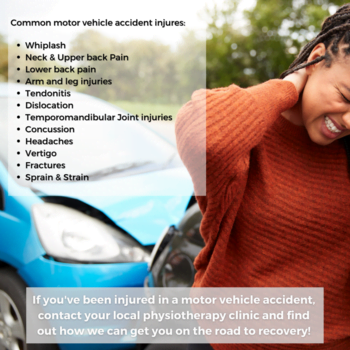What is a whiplash injury?
Whiplash is the most common motor vehicle accident injury. Whiplash injuries are described as an acceleration-deceleration injury. They are associated with sports injuries, falls, and most commonly car accidents. When vehicles collide in a motor vehicle accident, the impact creates a force that affects the body. In the case of being rear-ended, our neck may abruptly move backwards and then forwards. This quick and unexpected movement causes injury to the soft tissues and muscles surrounding this region. This type of injury can affect other regions of our bodies as well, such as the shoulders and back. Unfortunately, pain, stiffness, and headaches are common symptoms that are experienced next.

What to expect from Physiotherapists?
As physiotherapists, we get it. You did not ask for this. Now you have to deal with insurance, possibly lawyers, as well as pain and stiffness. The experience of dealing with everything is stressful and overwhelming.
We understand and we are here to help!
The role of physiotherapists in this troubling time is to help alleviate your pain and help you return to living your normal life. The rehabilitation process, however, is not straightforward and truthfully, it will be challenging–there will ups and downs, hopefully, more ups than downs, but the end goal will be well worth it.
What happens during a physiotherapy session?
- Physiotherapists will first check for red flags to make sure that there are no serious injuries that may warrant immediate medical attention. Thankfully, these types of injuries do not occur often.
- We will then provide a comprehensive assessment of the regions of pain that you are experiencing.
- From there on, we will provide you with a treatment plan catered to your specific needs.
Treatment Techniques
Exercise
The plan will involve therapeutic exercises, which is our most important tool to help alleviate your symptoms. The exercises will focus on regaining range of motion, alleviating tightness, as well as strengthening the supporting structures.
Of course, there are other tools in the toolbox that we can use in addition to exercises. These include:
- Manual therapy
- Thermal and electro-modalities
- Acupuncture and dry needling
Exercises, however, is what make up the core of our treatment plan.
How to make the best of your treatment session?
- Keep an open mind and a positive attitude as best as you can.
We want you to come to physiotherapy with a determined attitude to tackle this injury. That being said, there are going to be days that are bad and that is completely fine. However, just know that physiotherapists are on your side and we are working towards the same goal and it can only get better from here.
- Be transparent with us.
We want to know how you are managing the exercises. Understanding this allows us to tailor a treatment plan that moves at your pace and works for you.
- It is very important that you are diligent with the exercises. Being consistent with your exercise treatment plan is what is going to get you better.
Of course, there are days when it may be difficult and that’s okay…but take a break and get right back on it.
- Lastly, we want you to tell us how you are coping with the whole situation.
We are here to not only alleviate your symptoms but we are also here to provide you with the support you need. If you’ve been in a recent motor vehicle accident, don’t hesitate to call us to start the booking process. There is some initial paperwork required, but we will provide you with the resources you need!
Brandon Hoang
Physiotherapist at Pivotal Physiotherapy
